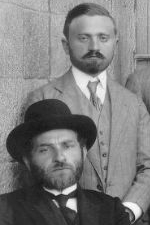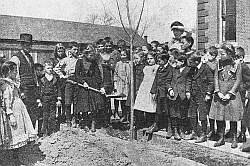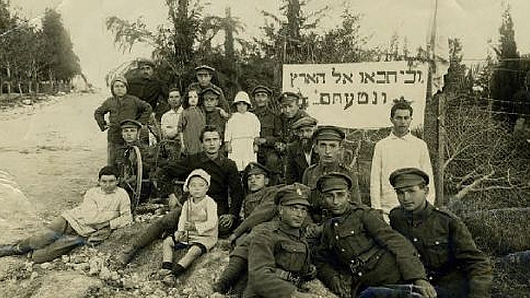It’s a little-known quirk of timing and history that the transformation of Tu B’Shvat, which in 2017 fell on Feb. 11, from an obscure Kabbalistic holiday to its current incarnation can trace its origins to a Christian-oriented, proto-environmentalist activity in 19th-century Nebraska, as reinterpreted by a radical early Zionist.

Chaim Aryeh Leib Zuta (1868-1939) landed on Jaffa’s shores in December 1903. He was already a well-known figure among the nascent Hebrew culture of Eastern Europe, and was one of the first advocates of the “reformed heder,” a schooling system that taught modern secular subjects alongside traditional religious ones.
In the 18th century, Kabbalists had developed a ritual of eating fruits in a particular order and drinking four cups of wine, as an allusion to the Passover seder. Tu B’Shvat also spread through Jewish popular culture of Eastern Europe as a holiday mainly intended for children. It was a day off from school, and teachers bought their students fruits and sweets. Yet the majority of Jewish communities knew Tu B’Shvat – if at all – as the marginal “holiday of the fruits,” marked by customs related to fertility and not necessarily to the land of Israel.
Just a few weeks after settling in Jaffa and while teaching in the girls’ Hebrew school there, Zuta wrote about two tree festivals he knew from Russia. As a child, he yearned to be in the warm Holy Land, while he prayed in his cold environs to reunite with its trees and bless them for their new year. His adult memory was of a merry celebration in Ekaterinoslav (today’s city of Dnipropetrovsk in Ukraine), in which children planted trees in a festive spring ceremony. As jolly as the celebration was, Zuta was gloomy, saying, “Blessed is the nation that plants trees in its own land! Alas, the students from my people walk and plant saplings in a foreign soil, where they do not belong, and my heart is mournful!”
Zuta hoped that “there, in the land of Israel, the new year for the trees is indeed the 15th of Shvat [on the Hebrew calendar]…and is probably a big deal.”
How disappointed he was to find out that none of this had its roots in the real land of Israel.

The Russian celebration that inspired Zuta was a 19th-century invention from the American Midwest. As industrialization progressed around the world and forests began shrinking, proto-environmentalist movements began waging pro-forest campaigns. Nebraska proclaimed April 10, 1872, as “Arbor Day.” More than a million trees were planted; two years later, the state legislature enshrined Arbor Day as an annual holiday.
Planting ceremonies included parades of schoolchildren carrying saplings, songs composed for the holiday and the recitation of biblical passages. In many places, the ceremonies had a distinctly Christian tone.
Within two decades, most of the U.S. and Canada had enacted an Arbor Day meant to inspire children and adults with a love of nature, environmental awareness, and local and national patriotism. By the end of the century it had spread to Australia, New Zealand, France and Spain. It even reached the industrialized parts of the Russian empire.
Zuta was the first to suggest a Jewish Arbor Day. In his mind, he was not inventing a tradition but rather innovating it. He argued that Arbor Day “was ours, its time was the 15th of Shvat, but the gentiles replaced it with a different day, while proclaiming ownership on the festival.”
At the 1906 convention of the Association of Hebrew Teachers in Palestine, Zuta proposed making it obligatory for schools to celebrate a tree-planting holiday on Tu B’Shvat. Despite noting the overcast weather of this frequently muddy season, the proposal was accepted. The next year, the first public tree-planting ceremony on Tu B’Shvat took place at the Mikveh Yisrael agricultural school, which today is within metropolitan Tel Aviv, with the participation of some 300 students from five schools in nearby Jaffa.
On Tu B’Shvat in 1910, the students of most of Jaffa’s Jewish schools -including the non-Zionist, non-Hebrew speaking Alliance Francaise – held ceremonies in the new Jaffa neighborhood of Ahuzat Bayit, whose first residents had just moved in. For several years, the children of Jaffa planted trees in Ahuzat Bayit, soon renamed Tel Aviv.
In 1913, after Zuta had moved to Jerusalem to serve as the headmaster of the Laemel School, he helped organize a tree-planting ceremony that drew 1,500 students from all the Jewish schools in the city – religious and modern, boys and girls, Ashkenazim and Sephardim, from the Old Yishuv and New Yishuv immigration waves.
They planted trees in the nearby agricultural colony of Motza, now an upscale Jerusalem suburb. It was one of the most striking festivities yet seen in Mandatory Palestine, which was not accustomed to Jewish public events. Excited and likely exaggerated descriptions in the Hebrew press recounted 10,000 adults traveling from Jerusalem in carriages, on donkey back and by foot to watch the show.
Tu B’Shvat owes its rapid canonization in the Yishuv era, and thereafter in the entire Jewish world, to the strong desire that many Jewish urbanites – regardless of their affiliations – felt for village and rural life, and for their hope that the new Jewish agriculture would give rise to a more authentic Jewish culture.


























